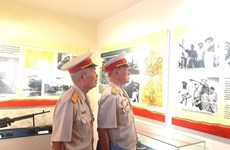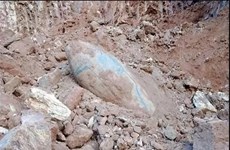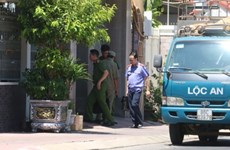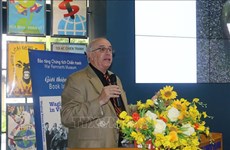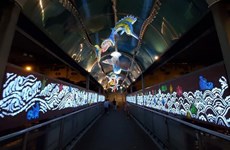Ancient citadel's wall unearthed
Archaeologists have unearthed a section of the relics of the Thang Long
Imperial Citadel wall dating back to the Le So (Early Le) Dynasty
(15th-18th century), saying it will help with research into the citadel.
Archaeologists have unearthed a section of the relics of the Thang Long
Imperial Citadel wall dating back to the Le So (Early Le) Dynasty
(15th-18th century), saying it will help with research into the citadel.
The section was excavated at a construction site between Van Cao and Hoang Hoa Tham roads.
The findings further confirmed archaeologists' predictions from the first excavation in 2010 that "this was a section of the northern wall of the Citadel from the Le So dynasty and was inside the citadel in the Ly and Tran dynasties (in the 11th-15th century)."
"Seventeen cultural layers, 7.4m underground were found at the 200sq.m site," a member of the excavation team said on Dec. 19.
At the 15th cultural layer, experts discovered organic dust and the remains of food waste including oyster and mussel shells. They also found broken bricks and tiles, pottery, and enamel bowls dating back to the Ly and Tran dynasties.
The first 14 cultural layers showed that the soil found was used to entrench the citadel.
This type of soil is said to belong to two different periods. The first period belonged to the Ly and Tran dynasties with the soil mixed with coal ash and small, thin bricks. The soil from the Le So dynasty was mainly sourced from production areas such as the foundations of incinerators and pottery kilns.
Noticeably, archaeologists discovered a solid foundation pit 4.3m wide and 12m long. The foundations were said to be extremely strong with a mixture of six layers of materials and five layers of clay. There, excavators found metal, pottery, crockery and kilns dating back to the Ly, Tran and Le periods.
According to archaeologists, pottery unearthed resemble those found in the Thang Long Citadel. They were imprinted with characters and dragons. These characteristics show that they were high quality products ordered specifically as gifts.
These objects are expected to have great meaning to the cultural heritage of the citadel, they said.
In other words, vestiges and relics found here will provide material for the research of the structure of the Thang Long Citadel in the Ly, Tran and Le periods.
Excavators plan to make a preliminary report on the findings.
Luu Tran Tieu, chairman of the National Heritage Council, recommended preserving a section of the wall that showed a complete view of all 17 cultural layers to display to the public.
However, archaeologist Pham Quoc Quan, a member of the excavation team, said despite its important value, it will be very difficult to turn the site into an open air tourist attraction because it is situated in the middle of a road.
"In the process of mapping out and implementing this traffic project, relevant authorities did not take into account the preservation of any archaeological finds that were made," said Quan./.
The section was excavated at a construction site between Van Cao and Hoang Hoa Tham roads.
The findings further confirmed archaeologists' predictions from the first excavation in 2010 that "this was a section of the northern wall of the Citadel from the Le So dynasty and was inside the citadel in the Ly and Tran dynasties (in the 11th-15th century)."
"Seventeen cultural layers, 7.4m underground were found at the 200sq.m site," a member of the excavation team said on Dec. 19.
At the 15th cultural layer, experts discovered organic dust and the remains of food waste including oyster and mussel shells. They also found broken bricks and tiles, pottery, and enamel bowls dating back to the Ly and Tran dynasties.
The first 14 cultural layers showed that the soil found was used to entrench the citadel.
This type of soil is said to belong to two different periods. The first period belonged to the Ly and Tran dynasties with the soil mixed with coal ash and small, thin bricks. The soil from the Le So dynasty was mainly sourced from production areas such as the foundations of incinerators and pottery kilns.
Noticeably, archaeologists discovered a solid foundation pit 4.3m wide and 12m long. The foundations were said to be extremely strong with a mixture of six layers of materials and five layers of clay. There, excavators found metal, pottery, crockery and kilns dating back to the Ly, Tran and Le periods.
According to archaeologists, pottery unearthed resemble those found in the Thang Long Citadel. They were imprinted with characters and dragons. These characteristics show that they were high quality products ordered specifically as gifts.
These objects are expected to have great meaning to the cultural heritage of the citadel, they said.
In other words, vestiges and relics found here will provide material for the research of the structure of the Thang Long Citadel in the Ly, Tran and Le periods.
Excavators plan to make a preliminary report on the findings.
Luu Tran Tieu, chairman of the National Heritage Council, recommended preserving a section of the wall that showed a complete view of all 17 cultural layers to display to the public.
However, archaeologist Pham Quoc Quan, a member of the excavation team, said despite its important value, it will be very difficult to turn the site into an open air tourist attraction because it is situated in the middle of a road.
"In the process of mapping out and implementing this traffic project, relevant authorities did not take into account the preservation of any archaeological finds that were made," said Quan./.









